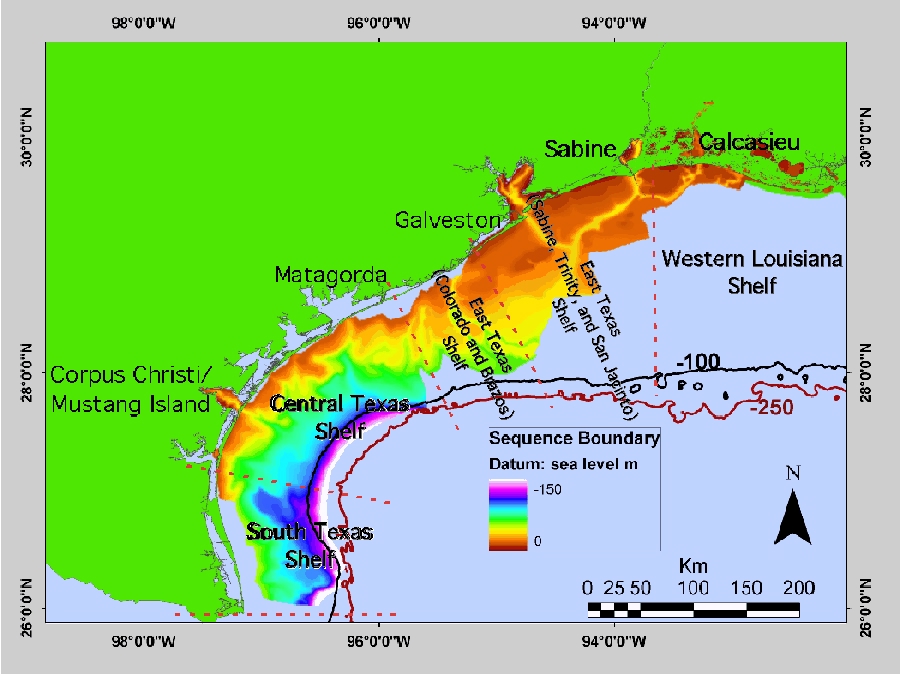

During the past decade there has been a proliferation of sequence stratigraphic models, including the notorious "slug diagrams", that attempt to relate information from seismic data, well logs, and outcrop studies, to the character and spatial and temporal distribution of depositional systems in the subsurface. The underlying assumption in such models is that there is some orderly stratigraphic motif for any given basin setting whereby the general style of deposition repeats itself with each eustatic cycle as long as other controlling factors (climate, sediment supply, shelf gradient, subsidence, etc.) remain relatively constant. The most practical models for exploration and production geology are those that are sensitive to the variability in depositional systems and can be adjusted to fit the boundary conditions of a given geologic setting.
We have studied the late Quaternary deposits of the Northern Gulf of Mexico and constructed modified slug diagrams for six different areas of the gulf. The differences in these models from the different parts of the gulf highlight the variability that can be found in any given systems tract. The models are shown here, but please explore our website to see the details behind them. For a more detailed discussion of the different study areas, see Society for Sedimentary Research Special Publication No. 79, "Late Quaternary Stratigraphic Evolution of the Northern Gulf of Mexico Margin", edited by John B. Anderson and Richard H. Fillon.
New and Upcoming Papers
- Anderson, J.B., Diachronous Development of the late Quaternary Shelf-Margin Deltas in the Northwestern Gulf of Mexico: Implications for Sequence Stratigraphy and Deep Water Reservoir Occurrence, in Bhattacharya, J., and Giosan, L., eds., Morpho-Sedimentary Evolution of Deltas, Society for Sedimentary Research, Special Publication, in press.
ABSTRACT: For the most part, delta development across the northern Gulf of Mexico shelf during the late Quaternary occurred throughout the falling limb of sea level (Anderson et al., 2004; Roberts et al., 2004). These deltas reached the shelf margin at different times, depending on the sediment supply of their fluvial feeders. These deltas have different morphologies, sediment facies patterns and stratigraphic architectures.
- Milliken, K.T., In search of the cause of catastrophic coastal change in Texas - West Louisiana Bay Evolution: A study of Sabine and Calcasieu coastal plain: Ph.D. thesis, Rice University, Houston, Texas.
- Rodriguez, A.B., Anderson, J.B., and Simms, A.R., in press, Terrace inundation as an autocyclic mechanism for parasequence formation: Galveston Estuary, Texas, Journal of Sedimentary Research.
- Rodriguez, A.B., Anderson, J.B., Siringan, F.P., and Taviani, M., Holocene evolution of the east Texas coast and inner continental shelf: along-strike variability in coastal retreat rates, Journal of Sedimentary Research, v. 74, p. 406-422.
- Simms, A.R., Late Quaternary/Holocene Evolution of the Nueces Incised Valley, Central Texas: Ph.D. dissertation, Rice University, Houston, Texas.
- Simms, A.R., Anderson, J.B., and Blum, M., Mustang Island, TX: An example of an aggradational barrier island: under review.
- Simms, A.R., Anderson, J.B., Taha, P.Z., and Rodriguez, A.B., in press, Over-filled versus under-filled incised valleys: examples from the Quaternary Gulf of Mexico, Society of Sedimentary Research Special Publication.
Click on each location for more information. (check back periodically for updates)

Gulf of Mexico Research Group
Department of Earth Science
Rice University
6100 Main Street
Houston, Texas 77005
Site updated on August 16, 2005.
This page has been accessed  times since February 16, 2000.
times since February 16, 2000.
Please see our other website!


Comments, questions? Contact us at
gulf@gulf.rice.edu.



 times since February 16, 2000.
times since February 16, 2000.

